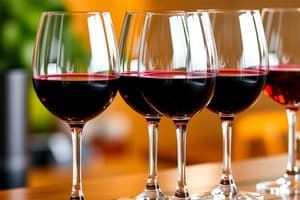Podcast
Questions and Answers
What is the purpose of spitting out wine during a formal wine tasting?
What is the purpose of spitting out wine during a formal wine tasting?
- To show disrespect to the wine
- To demonstrate expertise
- To avoid wasting wine
- To avoid getting intoxicated (correct)
What is the purpose of blind wine tasting?
What is the purpose of blind wine tasting?
- To showcase the wine's label and bottle shape
- To identify the wine's origin
- To make the wine taste better
- To ensure impartial judgment (correct)
What is the difference between vertical and horizontal wine tastings?
What is the difference between vertical and horizontal wine tastings?
- Vertical tastings compare wines from different regions, while horizontal tastings compare wines from the same region
- Vertical tastings compare wines from the same producer, while horizontal tastings compare wines from different producers
- Vertical tastings highlight differences between vintages of the same wine, while horizontal tastings compare wines from the same vintage (correct)
- Vertical tastings compare wines from the same vintage, while horizontal tastings highlight differences between vintages of the same wine
What is the purpose of a tasting note?
What is the purpose of a tasting note?
What is the impact of the temperature at which wine is served on its taste and smell?
What is the impact of the temperature at which wine is served on its taste and smell?
What is the purpose of swirling wine in a wine glass?
What is the purpose of swirling wine in a wine glass?
What is the purpose of wine schools offering wine tasting classes?
What is the purpose of wine schools offering wine tasting classes?
What is the purpose of difference tests in sensory analysis?
What is the purpose of difference tests in sensory analysis?
What is the impact of tasting 20-25 samplings of wine?
What is the impact of tasting 20-25 samplings of wine?
Flashcards are hidden until you start studying
Study Notes
Method of Judging Wine:
-
Wine tasting is a sensory examination and evaluation of wine, with a formalized methodology established from the 14th century.
-
Professional wine tasters use specialized terminology to describe the perceived flavors, aromas, and general characteristics of wine.
-
Scientific blind wine tasting suggests the unreliability of wine tasting in both experts and consumers, with inconsistency in identifying wines based on region and price.
-
The methodology of wine tasting was formalized by the 18th century, and the practice of tasting is as old as the history of wine.
-
Wine tasting is often done in isolation, but a wine's quality assessment is more objective when performed alongside several other wines.
-
Blind tasting involves serving the wine without the taster(s) having seen the label or bottle shape to ensure impartial judgment.
-
Expectations about wines based on their geographic origin, producer, vintage, color, and other factors can bias a taster's judgment.
-
Vertical and horizontal wine tastings are arranged to highlight differences between similar wines, and tasting flights involve sampling and comparison of wines.
-
A tasting note is a taster's written testimony about the aroma, taste identification, acidity, structure, texture, and balance of a wine.
-
The temperature that a wine is served at can greatly affect the way it tastes and smells, and the shape of a wineglass can have a subtle impact on the perception of wine.
-
The bouquet of wine is best revealed by gently swirling the wine in a wine glass to expose it to more oxygen and release more aromatic etheric, ester, and aldehyde molecules that make up the essential components of a wine's bouquet.
-
As part of the tasting process, and as a way of comparing the merits of the various wines, wines are given scores according to a relatively set system.Wine Tasting and Sensory Analysis
-
Wine tasters usually spit the wine out after assessing its quality at formal tastings to avoid getting intoxicated.
-
Tasting plays an important role in sensory analysis and consumer preference testing of wine.
-
Oenologists perform various tests on the taste, aroma, mouthfeel, and appeal of wines.
-
Difference tests help determine whether different fermentation conditions or new vineyard treatments alter the character of a wine.
-
Preference testing establishes consumer preference, while descriptive analysis determines the most prominent traits of the wine.
-
Blind tasting and other laboratory controls help mitigate bias and assure statistically significant results.
-
Many large wine companies have their own sensory teams consisting of a Ph.D. sensory scientist, a flavor chemist, and a trained panel.
-
Wine schools offer wine tasting classes to the public and professional training for sommeliers and winemakers.
-
E-learning programs are also available to learn how to assess wine methodically.
-
Wine grape varieties are evaluated according to a wide range of descriptors that draw comparisons with other non-grape flavors and aromas.
-
Wine tasting etiquette includes spitting, inquiring about where to spit, and using a spittoon.
-
Tasting from twenty to twenty-five samplings can still produce an intoxicating effect, depending on the alcoholic content of the wine.
Studying That Suits You
Use AI to generate personalized quizzes and flashcards to suit your learning preferences.




